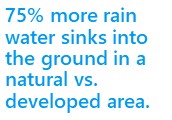The Perfect Landscape
You can create a beautiful outdoor space and protect our waters.
A gorgeous home landscape doesn’t need to come at the price of clean lakes and streams. We can have both. But to make it happen, we all need to think a little differently.
Less Hard Surface
The more concrete or blacktop your property has, the more water will run off the property and into storm drains and ditches. Seventy-five percent more rain  water sinks into the ground in a natural versus developed area. Stormwater that flows from developed areas also carries oil, grease, fertilizer, bacteria, exhaust particles, etc. Planning for minimal hard surface on your property makes good sense. Consider the amount of runoff that will be generated by roofs, pavement and sidewalks. Focus on natural plantings to slow water so that it filters into the ground rather than runs off. Where needed, install pavement such as open bricks that allow water to sink into the ground. Minimizing runoff reduces damage to your property and others down stream. It may also save you money if you live in a city that has a stormwater utility, since storm water utility fees are based on the amount of runoff your property sends to the storm sewer system.
water sinks into the ground in a natural versus developed area. Stormwater that flows from developed areas also carries oil, grease, fertilizer, bacteria, exhaust particles, etc. Planning for minimal hard surface on your property makes good sense. Consider the amount of runoff that will be generated by roofs, pavement and sidewalks. Focus on natural plantings to slow water so that it filters into the ground rather than runs off. Where needed, install pavement such as open bricks that allow water to sink into the ground. Minimizing runoff reduces damage to your property and others down stream. It may also save you money if you live in a city that has a stormwater utility, since storm water utility fees are based on the amount of runoff your property sends to the storm sewer system.
Rain Gardens
Rain gardens are slight depressions in a yard that act as receiving areas for rain water that runs off your roof and downspouts. Rain gardens capture rainwater
before it picks up oil, grease, fertilizer, pet waste or other contaminants. Rain gardens replenish groundwater by infiltrating runoff, rather than passing it into the stormwater system. Often they’re planted with native plants that thrive on moisture, but can withstand a dry period, too.
Rain Barrels
A rain barrel captures water that flows from a roof through downspouts. Commonly, the rain barrel is a 55-gallon drum designed specifically to hold water without creating a mosquito breeding habitat. A tight fitting lid, seal for the downspout, and filtered overflow valve allow overflow water to move away from the rain barrel.
Stormwater is rain or snowmelt and water from things people do, like overwatering the lawn or discharging pool water into the street drain. We can choose products carefully and shape our lawns and pavement so water sinks in. When we do, runoff is reduced, pollutants filter out and streams and groundwater are protected.
Untreated runoff is the biggest threat to our nation’s water quality, according to the U.S. Environmental Protection Agency. Let’s make the small, important changes that will reduce that threat and improve water quality and our lives!
